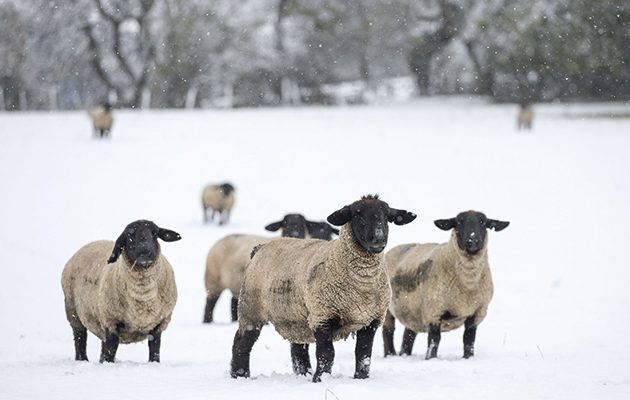The life of a stockman can be made a happier one at this time of year, says Tim Field, with such things as swivelling troughs, rotating brushes – and even a “Moocall”
February is a dark, dormant time for the stockman. But his life can be made a happier one at this time of year, with state of the art, modern farming technologies, says Tim Field.
For more on farming, read hedging your bets on hedgerows as Tim Field looks into the benefits of restoring the patchwork quilt.
THE STOCKMAN IN FEBURARY
In the short, dark days of February the landscape is quiet, still, mothballed; the vitality of seasons past has moved into deep senescence. Autumn fruits have long gone and any sensible life forms are tucked away in hibernation. The farming calendar follows suit and weeks pass without any apparent growth in the dormant winter cereals, stubbles and pastures. There is a visible scarcity of livestock in the fields, limited to a few groups on over-wintering pastures, fodder roots or kale. The twice-daily pilgrimage of a dairy cow from field to parlour is temporarily on hold.
While some holdings are capable of out-wintering stock, others look like the Somme within a few days of foul weather. When grass growth stops, transpiration slows and wet ground becomes soft. Hoof and mechanical poaching leads to degraded soil structure, erosion, nutrient run-off, soured soils, ineffective grass recovery and disturbed seedbanks cause an imminent weed burden. Gateways become an obstacle only the brave traverse. Even on the wettest of days in mid-summer, a vehicle making a mess on damp pasture will soon green-up again, whereas in February a field scars with tell-tale signs remaining deep into spring.
The dairy girls have long been away from their paddocks and are settled in for the season, enjoying a carefully weighed up ration of forage and supplements spat into the feed passage with a single pass of the wagon. The precision diet is essential when harvesting milk twice a day or drying off for calving.
On beef and sheep systems, light ground that resists gentle animal traffic is a valuable asset in winter. Those that don’t profit from such free-draining soils benefit greatly from housing. On our heavy clay, beef cows come in for the first wave of calving – grass growth permitting – at the beginning of November. It has been seven months since the previous calving and weaning, with safe separation in sheds bringing added security; wire fencing can prove wholly inadequate where a determined mother wants to get back to her baying calf. Inside, the stress on cow and weaned young can be managed, while also optimising her body condition as the majority start calving in late February.
There is an eerie silence in the turkey sheds with the passing of Christmas – time for a deep clean ready to house the sheep. They have quietly grazed back the thinning pastures and are looking for supplementary feeding as lambs are set and the countdown begins. Ewes are scanned, shorn and sorted into wards for singles, twins and triplets; the triplets getting extra rations and singles held back from putting on too much fat. As with the dairy and beef, micro-managing ewes at this time is important if the stockman wants to reduce difficulty at lambing.
Back in summer, species-rich leys offered plenty of grass for grazing and harvesting silage. Cut at its peak and ensiled, carbohydrates and proteins are conserved with all the sustenance required for hungry stock in winter. Hay has the valuable attribute of fulfilling appetites without the aninmals putting on too much fat. Various legumes and other herbs give the balance of energy, protein, natural anthelmintic properties, palatability and diet diversity to suit naturally roaming, grazing, ruminant herbivores through a sedentary winter.
High-welfare systems employ deep-litter bedding, with fresh straw every day or two and the shed mucked out entirely every four to six weeks. Straw provides an excellent carbon filter for the sloppy stuff; the wet soaks in and the volatiles (such as ammonia) are absorbed. Ideally, this is mucked out into a covered store and then taken for composting in-field when ground conditions allow. Slurry-based systems, without the straw to mop up, face ever-increasing challenges nowadays. Nitrate Vulnerable Zones restrict field application and legislative demands on storage capacity require significant investment to prevent the release of effluent and volatiles. However, that is small change to the expense of managing these pollutants once they’ve escaped and Thames Water recently announced funds to help farmers in our catchment.
Like much of modern farming, livestock sheds can be state of the art. Fitted with solar panels and rainwater harvesting, utility bills become credit notes. Ventilation is optimised, avoiding the risks of pneumonia while preventing a chill. Water troughs swivel for ease of cleaning – an all-important trick when the stock defecates into its drinking vessel – as clean, dry and hygienic are essential attributes of housing. Buildings can take the stress out of handling and certain kit helps to calm, such as rotating brushes to rub against, massage and relax. If that’s not taking the hardship from the role of the stockman, the zooming cameras and “Moocall” (a sensor sends a text when the cow is calving) mean stockmen can be informed and observe from beneath a duvet. That’s not a bad place to be while the hardy, out-wintering stockmen are faced with digging sheep out of snow or rescuing animals from floodplain pastures hit by a swollen river.
Follow Tim and Agricology @agricology





